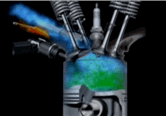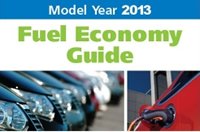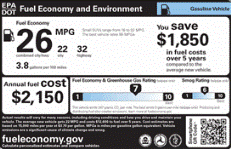Engine Technologies

Also called variable valve actuation (VVT), variable-cam timing and variable valve timing and lift electronic control (VTEC®)
Valves control the flow of air and fuel, into the cylinders and exhaust out of them. When and how long the valves open (timing) and how much the valves move (lift) both affect engine efficiency.
Optimum timing and lift settings are different for high and low engine speeds. Traditional designs, however, use fixed timing and lift settings, which are a compromise between the optimum for high and low speeds. VVT&L systems automatically alter timing and lift to the optimum settings for the engine speed.
| Potential Efficiency Improvement: |
5% |
| Savings Over Vehicle Lifetime: |
$1,600* |

Also called multiple displacement, displacement on demand (DOD), and variable cylinder management
This technology merely deactivates some of the engine's cylinders when they are not needed. This temporarily turns a 8- or 6-cylinder engine into a 4- or 3-cylinder engine. This technology is not used on 4-cylinder engines since it would cause a noticeable decrease in engine smoothness.
| Potential Efficiency Improvement: |
7.5% |
| Savings Over Vehicle Lifetime: |
$2,400* |

Turbochargers and superchargers are fans that force compressed air into an engine’s cylinders. A turbocharger fan is powered by exhaust from the engine, while a supercharger fan is powered by the engine itself.
Both technologies allow more compressed air and fuel to be injected into the cylinders, generating extra power from each explosion. This allows manufacturers to user smaller engines without sacrificing performance.
Additional Information: How Turbochargers Work
| Potential Efficiency Improvement: |
7.5% |
| Savings Over Vehicle Lifetime: |
$2,400* |

Also called fuel stratified injection or direct injection stratified charge
In conventional multi-port fuel injection systems, fuel is injected into the port and mixed with air before the air-fuel mixture is pumped into the cylinder. In direct injection systems, fuel is injected directly into the cylinder so that the timing and shape of the fuel mist can be precisely controlled. This allows higher compression ratios and more efficient fuel intake, which deliver higher performance with lower fuel consumption.
| Potential Efficiency Improvement: |
12% |
| Savings Over Vehicle Lifetime: |
$3,800* |
These systems automatically turn the engine off when the vehicle comes to a stop and restart it instantaneously when the accelerator is pressed so that fuel isn't wasted for idling. In addition, regenerative braking is often used to convert mechanical energy lost in braking into electricity, which is stored in a battery and used to power the automatic starter.
| Potential Efficiency Improvement: |
8% |
| Savings Over Vehicle Lifetime: |
$2,500* |
Potential fuel efficiency improvement:
Energy and Environmental Analysis, Inc. 2005. Automotive Technology Cost and Benefit Estimates. Arlington, Virginia, March.
Average light-duty vehicle fuel economy:
Heavenrich, R. M. 2005. Light-Duty Automotive Technology and Fuel Economy Trends: 1975 Through 2005. Office of Transportation and Air Quality, U.S. Environmental Protection Agency, Washington, D.C.
Average vehicle lifetime:
Calculated based on Transportation Energy Data Book, Edition 24. Oak Ridge National Laboratory, Oak Ridge, Tennessee, Tables 3.9 & 8.13.













